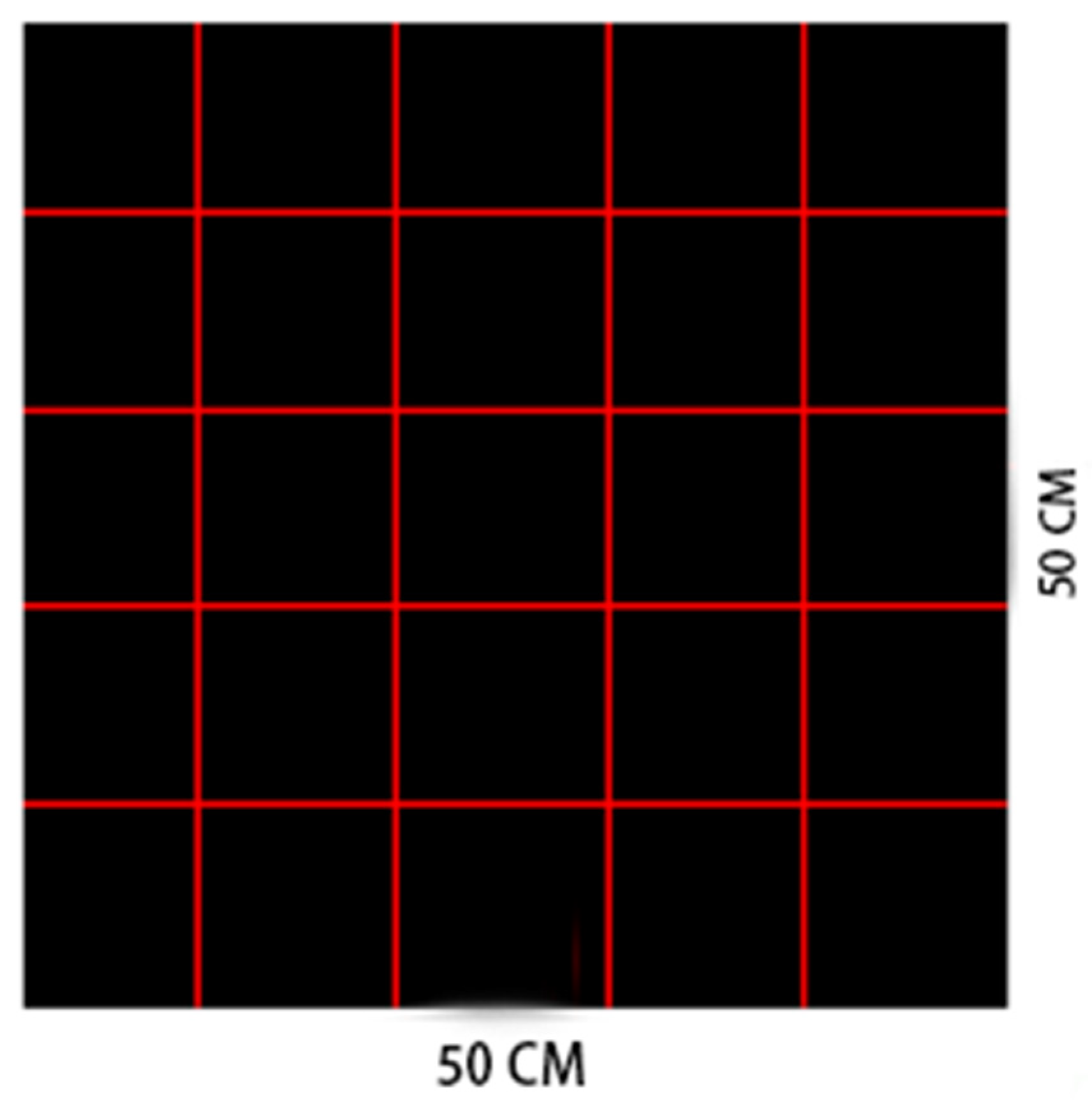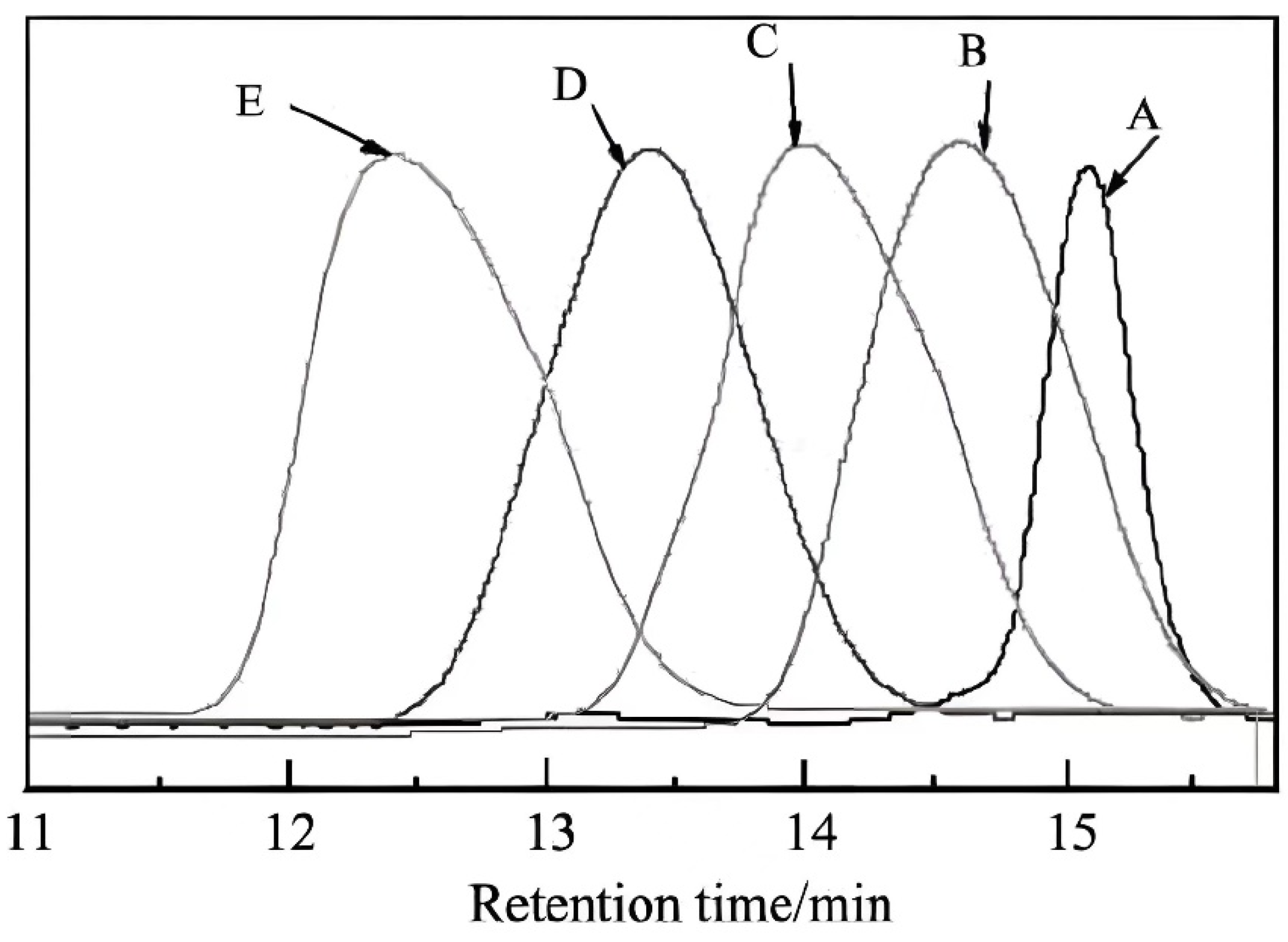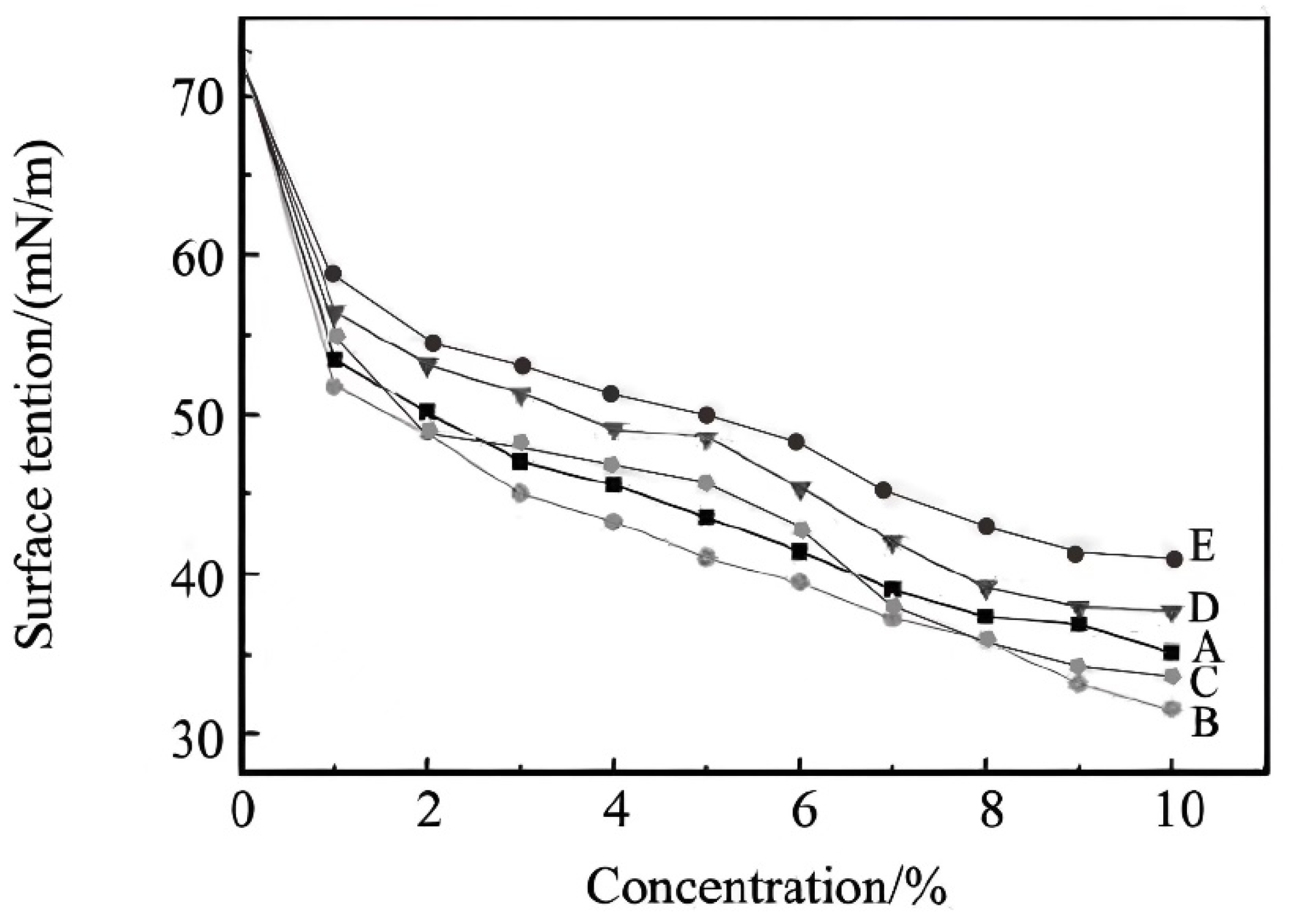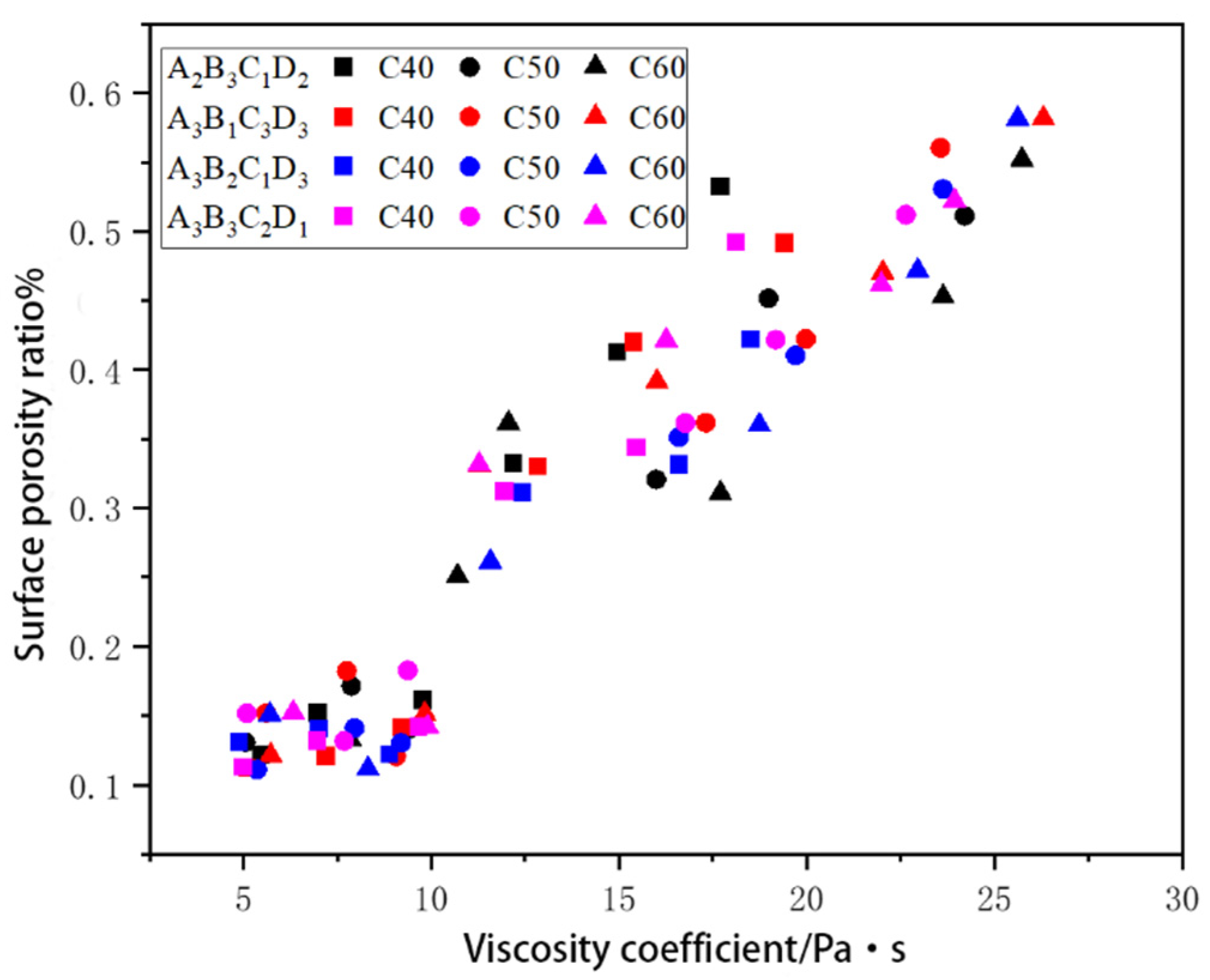Synthesis and Performance of Polycarboxylate Superplasticizer with Viscosity-Reducing and Low-Shrinkage Properties for Fair-Faced Concrete
Abstract
1. Introduction
2. Materials and Methods
2.1. Raw Materials
2.2. Experimental Materials
2.3. Main Instrumentation
2.4. Synthesis of Low-Shrinkage, Viscosity-Reducing Water-Reducing Agent
- For the synthesis of low-shrinkage functional monomer, diethylene glycol monobutyl ether, maleic anhydride, and catalyst were directly added into a four-necked bottle, reacted at 100–140 °C for 5 h, distilled under reduced pressure, cooled, and discharged for spare material.
- For the she synthesis of low-shrinkage, viscosity-reducing polycarboxylate water-reducing agent, we weighed hydrogen peroxide, sodium methallyl sulfonate, and water and added them to a three-necked flask containing the macromonomer MPEGnMA, which was stirred and heated in a water bath for 15 min. The mass ratio of the components was hydrogen peroxide: sodium methallyl sulfonate: macromonomer MPEGnMA = 1:4:120. Simultaneously, we added components A and B drop-wise. Component A was the low-shrinkage functional monomer, consisting of 12 g of acrylic acid and 28 g of water. Component B was the Vc aqueous solution, consisting of 0.2 g of Vc and 46 g of water. With a drop rate of 0.22 mL/min, the addition of components A and B was completed in 3 h and 3.5 h, respectively, which was followed by maintaining the reaction temperature for 1 h. After cooling, the pH value of the reactants was adjusted to neutral with NaOH solution at a concentration of 40%, and the mother liquor of polycarboxylic acid water-reducing agent obtained at the end of the reaction was loaded into a dialysis bag (the molecular weight of retention was 5000), and the volume of the water-reducing agent accounted for one-fifth of the capacity of the dialysis bag. The water was changed 4–6 times per day, and the required low-shrinkage and viscosity-reducing polycarboxylic acid water-reducing agent could be obtained after one week of dialysis. After one week of dialysis, the required low-shrinkage and viscosity-reducing polycarboxylic acid water-reducing agent was produced.
2.5. Performance Testing and Characterization
2.5.1. Gel Permeation Chromatography (GPC) Analysis
2.5.2. Surface Tension Test
2.5.3. Concrete Shrinkage
2.5.4. Net Cement Paste Test
2.5.5. Concrete Tests
2.5.6. Experiment on Controlling the Viscosity of Concrete and Its Impact on the Appearance of Fair-Faced Concrete
- (1)
- Raw material
- (2)
- Specimen preparation
- (3)
- Experimental design
- (4)
- Parameter measurement method of adjustment and determination of yield stress and plastic viscosity coefficient
- (5)
- Quantitative measurement and evaluation methods of the apparent voids in fair-faced concrete
- Image capture: Imported the photo of the fair-faced concrete surface into the software, as shown in Figure 2a.
- Dimensional calibration: Clicked on the measurement calibration tool and dragged the ruler to two scales in the image to obtain the number of pixels between the two scales. The measured data were then converted to represent the actual measured length. Utilized Image-Pro-Plus 6.0 to calibrate the dimensions of the fair-faced concrete image, input the actual dimensions of the fair-faced concrete, and annotated the dimensions of the fair-faced concrete structure and the voids on its surface in the software, as shown in Figure 2b.
- Pore determination: For image grayscale processing and selection of the grayscale value of the pores, since the voids in the photo were black, the “automatic bright objects” option was selected. The purpose of binarization is to present two extreme colors (black or white) for the holes and hole walls in the image to improve measurement identification and calculation accuracy. When conducting grayscale binarization processing, the grayscale value of the voids was selected to distinguish between the concrete and the apparent voids, as shown in Figure 2c.
- Data export: Clicked on “measurement data” to view and output collected results, including surface void area percentage and other data, and clicked “statistics” to summarize all data.
3. Results and Discussion
3.1. Molecular Weight and Its Distribution of Low-Shrinkage, Viscosity-Reducing Polycarboxylic Acid Water-Reducing Agent P(MAH-MPEGnMA)
3.2. Surface Tension Test of Low-Shrinkage, Viscosity-Reducing Polycarboxylic Acid Water-Reducing Agent in Aqueous Solution
3.3. Concrete Shrinkage
3.4. Effect of Low-Shrinkage, Viscosity-Reducing Polycarboxylic Acid Water-Reducing Agent on the Flow Properties of Net Mortar
3.5. Effect of Low-Shrinkage and Viscosity-Reducing Polycarboxylic Acid Water-Reducing Agent on the Application Performance of Fresh Concrete
3.6. Relationship between Surface Porosity Quantity and Plastic Viscosity Coefficient
4. Conclusions
- (1)
- Methyl polyethylene glycol methacrylate macromonomer (MPEGnMA) and methacrylic acid (MAA) were used as the main raw materials to synthesize a viscosity-reducing polycarboxylate water-reducing agent. The molecular weight and its distribution in the synthesized product were characterized by GPC. The GPC spectrum showed that the formed polymer structure was relatively ideal.
- (2)
- Experiments were conducted to test the surface tension of the water reducing agent in aqueous solutions, its effect on the fluidity of cement pastes, and its performance in freshly mixed concrete. The surface tension test revealed that when the concentration of P(MAH4-MPEG45MA)9 was 10%, the surface tension of the solution decreased significantly from 72.47 mN/m to 30.56 mN/m. The 72 h shrinkage value of concrete was reduced by 20.6% compared to that of the conventional control group. In the cement paste fluidity experiment, it was found that when the MAH:MPEGnMA ratio was 4:1, P(MAH4-MPEG16MA)9 maintained an optimal side chain density and number of functional groups, resulting in the best initial fluidity and fluidity retention ability. The testing of freshly mixed concrete showed that using a 1.0% dosage of the low-shrinkage, viscosity-reducing polycarboxylate water-reducing agent yielded the best results.
- (3)
- The influence of the plastic viscosity coefficient on the apparent voids of fair-faced concrete was investigated through orthogonal combination experiments, which determined a numerical interval with higher robustness. Specifically, when the plastic viscosity coefficient was between 5 and 10 Pa·s, the apparent void grade of the fair-faced concrete was simultaneously excellent and good.
Author Contributions
Funding
Institutional Review Board Statement
Informed Consent Statement
Data Availability Statement
Conflicts of Interest
References
- Pu, X. Research and application of ultrahigh-strength concrete. Concrete 1993, 10. [Google Scholar]
- Wu, Z.; Lian, H. High Performance Concrete; China Railway Publishing House: Beijing, China, 1999. [Google Scholar]
- Cai, C.Q.; Guo, Q.S.; Li, X. Experimental Research on Durability of Fair-Faced Concrete. Adv. Mater. Res. 2012, 535–537, 1693–1696. [Google Scholar] [CrossRef]
- Mao, J.; He, Z.; He, Y.; Lu, J.; Li, J. A Review of Effect of Mineral Admixtures on Appearance Quality of Fair-Faced Concrete and Techniques for Their Measurement. Sustainability 2023, 15, 14623. [Google Scholar] [CrossRef]
- Shi, J.; Wu, Z.; Zhuang, J.; Zhang, F.; Zhu, T.; Li, H. Synergistic Effects of SAP, Limestone Powder and White Cement on the Aesthetic and Mechanical Properties of Fair-Faced Concrete. Materials 2023, 16, 7058. [Google Scholar] [CrossRef] [PubMed]
- Liu, G.; Ge, Y. Influencing factors and improvement measures for the durability of fair-faced concrete. Anhui Archit. 2003, 121–122. [Google Scholar] [CrossRef]
- Zhang, T. Quality control of fair-faced concrete construction. Shanxi Archit. 2013, 39, 213–214. [Google Scholar] [CrossRef]
- Zhou, H.; Ye, T. Analysis of Evaluation Appearance Quality of Fair-Faced Concrete. Archit. Technol. 2009, 40, 641–642. [Google Scholar]
- Tang, J.; Zhong, W.; Ge, X.; Lu, S. Construction Technology of Dedicated Fair-faced Concrete Wall in Kunming New Airport Terminal. Constr. Technol. 2010, 39, 1–4+11. [Google Scholar]
- Weber, P. Post-treatment of concrete Improvement of the visual quality of fair-faced concrete surfaces. Betonw. Fert. Tech. 2010, 76, 36–39. [Google Scholar]
- Guo, W.; Lu, L.; Wang, L.; Cui, X.; Wang, G.; Zhang, H. Summary for Concept, Research Status, Existing Problems and Mix Proportion Design of Fair-faced Concrete. China Concr. Cem. Prod. 2016, 23–27. [Google Scholar] [CrossRef]
- Wallevik, O.H.; Wallevik, J.E. Rheology as a tool in concrete science: The use of rheographs and workability boxes. Cem. Concr. Res. 2011, 41, 1279–1288. [Google Scholar] [CrossRef]
- Zhou, L.; Wang, X. Control of apparent porosity in fair-faced concrete. Ready-Mix. Concr. 2016, 68–70. [Google Scholar]
- Mou, T.; Ding, Q.; Huang, X.; Zhou, X.; Fan, B. Effect of paste viscosity on apparent quality of fair-faced concrete. Concrete 2015, 104–106. [Google Scholar]
- Wu, D. Research on Preparation and Performance of High-Strength Self-Compacting Fair-Faced Concrete and Quality Control; Southeast University: Nanjing, China, 2017. [Google Scholar]
- Peng, H.; Wu, D.; Wu, Z. Expansion mechanism of concrete expansion agent MEA. J. China Agric. Univ. 1999, 115–118. [Google Scholar]
- Ruiz-Cabrera, M.A.; Foucat, L.; Bonny, J.M.; Renou, J.P.; Daudin, J.D. Assessment of water diffusivity in gelatine gel from moisture profiles. II. Data processing adapted to material shrinkage. J. Food Eng. 2005, 68, 221–231. [Google Scholar] [CrossRef]
- Liang, Y.B.; Mou, T.M.; Ding, Q.J.; Zhou, X. Effects of additives on the properties of clear-water concrete with mechanism sand. Concrete 2015, 115–118+122. [Google Scholar]
- GB/T 8077-2012; Methods for Testing Uniformity of Concrete Admixture. 2012. Available online: https://www.nssi.org.cn/nssi/front/81830473.html (accessed on 28 March 2024).
- GB/T 50082-2009; Standard for Test Methods of Long-Term Performance and Durability of Ordinary Concrete. 2009. Available online: https://www.nssi.org.cn/nssi/front/74303306.html (accessed on 28 March 2024).
- JGJ/T 283-2012; Technical Specification for Application of Self-Compacting Concrete. 2012. Available online: https://www.nssi.org.cn/nssi/front/81735323.html (accessed on 28 March 2024).
- Parr, W.C. Introduction to Quality Engineering: Designing Quality into Products and Processes. Technometrics 1989, 31, 255–256. [Google Scholar] [CrossRef]
- Roy, R.K. Design of Experiments Using the Taguchi Approach: 16 Steps to Product and Process Improvement; John Wiley & Sons: Hoboken, NJ, USA, 2001. [Google Scholar]
- Phadke, M.S. Quality Engineering Using Robust Design; Prentice Hall PTR: Saddle River, NJ, USA, 1995. [Google Scholar]
- Antony, J.; Perry, D.; Wang, C.; Kumar, M. An application of Taguchi method of experimental design for new product design and development process. Assem. Autom. 2006, 26, 18–24. [Google Scholar] [CrossRef]
- Freddi, A.; Salmon, M. Introduction to the Taguchi method. In Design Principles and Methodologies: From Conceptualization to First Prototyping with Examples and Case Studies; Springer: Berlin/Heidelberg, Germany, 2019; pp. 159–180. [Google Scholar]
- Muqeem, M. CHAPTER 2-Flow Drilling: Underbalance Drilling with Liquid Single-Phase Systems. In Underbalanced Drilling: Limits and Extremes; Rehm, B., Haghshenas, A., Paknejad, A., Al-Yami, A., Hughes, J., Schubert, J., Eds.; Gulf Publishing Company: Houston, TX, USA, 2012; pp. 83–85. ISBN 9781933762050. [Google Scholar]
- GB 55008-2021; General Code for Concrete Structures. 2021. Available online: https://www.nssi.org.cn/nssi/front/114718813.html (accessed on 28 March 2024).







| SiO2 | A2O3 | F2O3 | CaO | MgO | SO3 |
|---|---|---|---|---|---|
| 22.92 | 4.38 | 2.88 | 66.14 | 1.94 | 0.32 |
| N2Oeq | f-CaO | C3S | C2S | C3A | C4AF |
| 0.73 | 0.62 | 58.59 | 21.57 | 6.59 | 8.69 |
| SO3 | Na2O | CaO | P2O5 | MgO | Cl | K2O | Sum/% | Other/% |
|---|---|---|---|---|---|---|---|---|
| 28.36% | 22.55% | 21.48% | 0.957% | 0.674% | 0.538% | 0.524% | 75.083 | Spore nutrients |
| Strength Grade | Water-Cement Ratio | Water/kg·m−3 | Cement/ kg·m−3 | Fly Ash/ kg·m−3 | Mineral Powder/ kg·m−3 | Sand/ kg·m−3 | Stone/ kg·m−3 | Water Reducing Agent/% |
|---|---|---|---|---|---|---|---|---|
| C40 | 0.33 | 154 | 341 | 47 | 80 | 712 | 1068 | 1.2 |
| C50 | 0.29 | 152 | 398 | 42 | 84 | 639 | 1135 | 1.2 |
| C60 | 0.25 | 148 | 432 | 59 | 101 | 650 | 1060 | 1.2 |
| NO. | Level Combination | Experimental Condition | |||
|---|---|---|---|---|---|
| Cement | Water Reducing Agent | Sand | Stone | ||
| 1 | A1B1C1D1 | A1 | B1 | C1 | D1 |
| 2 | A1B2C2D2 | A1 | B2 | C2 | D2 |
| 3 | A1B3C3D3 | A1 | B3 | C3 | D3 |
| 4 | A2B1C2D3 | A2 | B1 | C2 | D3 |
| 5 | A2B2C3D1 | A2 | B2 | C3 | D1 |
| 6 | A2B3C1D2 | A2 | B3 | C1 | D2 |
| 7 | A3B1C3D2 | A3 | B1 | C3 | D2 |
| 8 | A3B2C1D3 | A3 | B2 | C1 | D3 |
| 9 | A3B3C2D1 | A3 | B3 | C2 | D1 |
| Rating | Excellent | Good | Unqualified |
|---|---|---|---|
| Evaluation | Maximum diameter is not greater than 4 mm, and the surface porosity area ratio is not more than 0.2%. | Maximum diameter is greater than 4 mm but less than or equal to 8 mm, and the surface porosity area ratio is not more than 0.2% | The surface voids area ratio exceeds 0.2%. |
| Entry | Feed Ratio (MAH:MPEGnMA) | Superplasticizer P(MAH-MPEGnMA)m | GPC Result | ||
|---|---|---|---|---|---|
| Mn/g·mol−1 | Mw/g·mol−1 | PDI | |||
| A | 3.5:1 | P(MAH3.5-MPEG16MA)5 | 5500 | 6800 | 1.25 |
| B | 4:1 | P(MAH4-MPEG16MA)9 | 10,600 | 15,200 | 1.42 |
| C | 4.5:1 | P(MAH4.5-MPEG16MA)12 | 15,200 | 21,100 | 1.38 |
| D | 4:1 | P(MAH4-MPEG45MA)9 | 22,000 | 31,200 | 1.41 |
| E | 4:1 | P(MAH4-MPEG67MA)9 | 30,100 | 41,800 | 1.39 |
| Entry | Superplasticizer P(MAA-MPEGnMA)m | Dosage/% | Fluidity/mm | ||
|---|---|---|---|---|---|
| Initial | 0.5 h | 1 h | |||
| A | P(MAA3.5-MPEG16MA)5 | 0.18 | 203 | 185 | 163 |
| B | P(MAA4-MPEG16MA)9 | 230 | 205 | 198 | |
| C | P(MAA4.5-MPEG16MA)12 | 222 | 171 | 148 | |
| D | P(MAA4-MPEG45MA)9 | 220 | 190 | 178 | |
| E | P(MAA4-MPEG67MA)9 | 205 | 170 | 139 | |
| Entry | Cement | Sand | Coarse Aggregate | P(MAH- MPEGnMA)m | VEA | Air-Entraining Agent | Water |
|---|---|---|---|---|---|---|---|
| 1 | 520 | 826 | 894 | 3.12 | 1.04 | 0.052 | 165 |
| 2 | 520 | 826 | 894 | 4.16 | 1.04 | 0.052 | 165 |
| 3 | 520 | 826 | 894 | 5.20 | 1.04 | 0.052 | 165 |
| 4 | 520 | 826 | 894 | 6.24 | 1.04 | 0.052 | 165 |
| Entry | P(MAH-MPEGnMA)m | W/% | V Funnel/s | T50/s | Slump Flow/mm | Segregation |
|---|---|---|---|---|---|---|
| 1 | P(MAH3.5-MPEG16MA)5 | 0.6 | 17 | - | 360 | No |
| 2 | P(MAH3.5-MPEG16MA)5 | 0.8 | 13 | 12 | 540 | No |
| 3 | P(MAH3.5-MPEG16MA)5 | 1.0 | 11 | 11 | 580 | No |
| 4 | P(MAH3.5-MPEG16MA)5 | 1.2 | 10 | 9 | 600 | No |
| 5 | P(MAH4-MPEG16MA)9 | 0.6 | 9 | 10 | 610 | No |
| 6 | P(MAH4-MPEG16MA)9 | 0.8 | 8.2 | 8 | 650 | No |
| 7 | P(MAH4-MPEG16MA)9 | 1.0 | 6.5 | 3.8 | 700 | No |
| 8 | P(MAH4-MPEG16MA)9 | 1.2 | 7.6 | 3.5 | 720 | Yes |
| 9 | P(MAH4.5-MPEG16MA)12 | 0.6 | 10 | 8.6 | 610 | No |
| 10 | P(MAH4.5-MPEG16MA)12 | 0.8 | 8.5 | 7.7 | 630 | No |
| 11 | P(MAH4.5-MPEG16MA)12 | 1.0 | 7 | 6.9 | 650 | No |
| 12 | P(MAH4.5-MPEG16MA)12 | 1.2 | 7.8 | 5.4 | 670 | No |
| 13 | P(MAH4-MPEG45MA)9 | 0.6 | 10 | 8 | 600 | No |
| 14 | P(MAH4-MPEG45MA)9 | 0.8 | 9 | 6.5 | 640 | No |
| 15 | P(MAH4-MPEG45MA)9 | 1.0 | 8.9 | 5.2 | 660 | No |
| 16 | P(MAH4-MPEG45MA)9 | 1.2 | 7.6 | 47 | 680 | Some mortar separated out |
| 17 | P(MAH4-MPEG67MA)9 | 0.6 | 16 | 13 | 540 | No |
| 18 | P(MAH4-MPEG67MA)9 | 0.8 | 13 | 10 | 570 | No |
| 19 | P(MAH4-MPEG67MA)9 | 1.0 | 10 | 8.6 | 610 | No |
| 20 | P(MAH4-MPEG67MA)9 | 12 | 8.6 | 7.5 | 630 | No |
Disclaimer/Publisher’s Note: The statements, opinions and data contained in all publications are solely those of the individual author(s) and contributor(s) and not of MDPI and/or the editor(s). MDPI and/or the editor(s) disclaim responsibility for any injury to people or property resulting from any ideas, methods, instructions or products referred to in the content. |
© 2024 by the authors. Licensee MDPI, Basel, Switzerland. This article is an open access article distributed under the terms and conditions of the Creative Commons Attribution (CC BY) license (https://creativecommons.org/licenses/by/4.0/).
Share and Cite
Li, W.; Qian, C.; Zheng, C.; Jiang, H.; Yu, Z.; Wu, Z.; Zhou, Z. Synthesis and Performance of Polycarboxylate Superplasticizer with Viscosity-Reducing and Low-Shrinkage Properties for Fair-Faced Concrete. Materials 2024, 17, 2685. https://doi.org/10.3390/ma17112685
Li W, Qian C, Zheng C, Jiang H, Yu Z, Wu Z, Zhou Z. Synthesis and Performance of Polycarboxylate Superplasticizer with Viscosity-Reducing and Low-Shrinkage Properties for Fair-Faced Concrete. Materials. 2024; 17(11):2685. https://doi.org/10.3390/ma17112685
Chicago/Turabian StyleLi, Wei, Chunxiang Qian, Chunyang Zheng, Haidong Jiang, Zhenxiao Yu, Zefan Wu, and Zhuang Zhou. 2024. "Synthesis and Performance of Polycarboxylate Superplasticizer with Viscosity-Reducing and Low-Shrinkage Properties for Fair-Faced Concrete" Materials 17, no. 11: 2685. https://doi.org/10.3390/ma17112685
APA StyleLi, W., Qian, C., Zheng, C., Jiang, H., Yu, Z., Wu, Z., & Zhou, Z. (2024). Synthesis and Performance of Polycarboxylate Superplasticizer with Viscosity-Reducing and Low-Shrinkage Properties for Fair-Faced Concrete. Materials, 17(11), 2685. https://doi.org/10.3390/ma17112685





